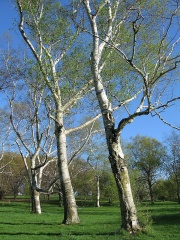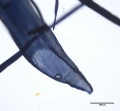Birch
Description
A hardy, deciduous tree of the family Betulaceae that is common to North America, Europe and Asia. Birch trees are readily distinguished by their white bark and diamond-shaped leaves. The wood is close-grained with a satinny texture that takes nice polish. The lightweight bark is full of natural waxes, oils and tannins that make it tough, durable, and waterproof. Thin sheets of bark were commonly used for paper in Central Asia and the Far East. The water-impervious bark was used for wigwams, canoes, and shoes for North American Indians. Birch produces a strong, pale yellow-brown wood with a close, straight grain and uniform texture that finishes to a smooth surface. It is sometimes dyed to imitate Mahogany. Birch is used for tools handles, Plywood, hoops, shoe heels, flooring, furniture, cabinetry, and firewood. Dyes can also be obtained from the leaves gathered before they develop a mature green color, produce a yellow dye while the soluble parts of the bark produce a pale brown color. The female catkins (a long shoot bearing flowers with no leaves) are boiled to produce a dull yellow color. Birch bark oil and birch beer are made from sap obtained from the trees. The sap, also called birch tar or Russian oil, and allows the wood to burn even when it is wet. It also produces a thermoplastic resin that is used as a waterproof adhesive, flavoring and fragrance.
For micrographs of thin sections, also see Paper birch, Yellow birch, and Black birch.
Synonyms and Related Terms
betula; birk (Dan.); bouleau (Fr.); Birke (Deut.); beulla (It.); abedul (Esp.); berk (Ned.); betula (Port.); bjørk (Nor.); brzoza (Pol.); björk (Sven.); black birch (Betula nigra); paper birch (Betula papyrifera); cherry birch (Betula lenta); yellow birch (Betula lutea); white birch (Betula pendula); sweet birch (Betula lenta); river birch (Betula nigra)
Risks
Links to Oddy Test results posted on AIC Wiki Materials Database Pages for individual materials below
° Birch Plywood Tested in 2016
° PureBond Birch Faced Plywood Tested in 2006
° PureBond Birch Faced Plywood Tested in 2006
Physical and Chemical Properties
- Tree height = 20-25m
- Bark = light gray to white, often peeling in papery strips
- Wood is moderately acidic.
- Color: light yellow-brown to reddish brown.
- Rings: obscure. Pores: diffuse, fine. Grain: faint. Rays: obscure. On quarter sawed wood, rays appear as small brown flakes.
- Hard, heavy, poor weatherability.
- Density = 32-48 ppcf.
- Specific gravity = 0.67.
- All species look alike microscopically (Alden).
Paper fiber type: hardwood, diffuse porous. Using transmitted light microscopy, pulp is identified by vessels with small diffuse pitting that may be alternate or arranged in a spiral. Perforations are scalariform with >10 bars (except river birch). Appearance with Graff "C" stain: dark blue, but varies with bleaching. Average dimensions of fibers: length, 1.8mm . 25μm wide. Common pulping method: kraft.
Working Properties
Birch wood is pale with a fine grain and produced a nice satin sheen. Plywood made from birch is lightweight and strong but not suitable for outdoor use.
Additional Images
Resources and Citations
- Schoch, W., Heller, I., Schweingruber, F.H., Kienast, F., 2004:Wood anatomy of central European Species: Common Birch, White Birch,Betula alba (B. pendula / B. pubescens)
- Alden Identification Services, Microscopic Wood Identification: Link
- Wikipedia: Birch (Accessed April 2020)
- Encyclopedia Britannica, http://www.britannica.com Comment: Retrieved May 25, 2003.
- F. H. Titmuss, Commercial Timbers of the World, The Technical Press Ltd., London, 1965 Comment: 35-48 ppcf
- John S. Mills, Raymond White, The Organic Chemistry of Museum Objects, Butterworth Heineman, London, 2nd ed., 1994
- Hardwood Manufacturers Institute, Memphis Tenn.: air-dry weight = 43 ppcf
- R. J. Gettens, G.L. Stout, Painting Materials, A Short Encyclopaedia, Dover Publications, New York, 1966
- G.S.Brady, Materials Handbook, McGraw-Hill Book Co., New York, 1971 Comment: p. 598
- Ralph Mayer, A Dictionary of Art Terms and Techniques, Harper and Row Publishers, New York, 1969 (also 1945 printing)
- Dictionary of Building Preservation, Ward Bucher, ed., John Wiley & Sons, Inc., New York City, 1996
- Virginia Tech Dendrochronology website at www.fw.vt.edu/dendro/dendrology/main.htm (accessed Oct. 3, 2005)
- Caring for your Collections, Arthur W Schulz (ed.), Harry N. Abrams, Inc. , New York, 1992
- Pam Hatchfield, Pollutants in the Museum Environment, Archetype Press, London, 2002
- Van Nostrand's Scientific Encyclopedia, Douglas M. Considine (ed.), Van Nostrand Reinhold, New York, 1976
- Random House, Webster's Encyclopedic Unabridged Dictionary of the English Language, Grammercy Book, New York, 1997
- The American Heritage Dictionary or Encarta, via Microsoft Bookshelf 98, Microsoft Corp., 1998
- CRC Handbook of Chemistry and Physics, Robert Weast (ed.), CRC Press, Boca Raton, Florida, v. 61, 1980 Comment: density=32-48 ppcf (0.51-0.77 g/cm3)
- Marja-Sisko Ilvessalo-Pfäffli. Fiber Atlas: Identification of Papermaking Fibers (Springer Series in Wood Science). Springer, 1995.
- Walter Rantanen. "Fiber ID Course." Integrated Paper Services. June 2013. Lecture.






